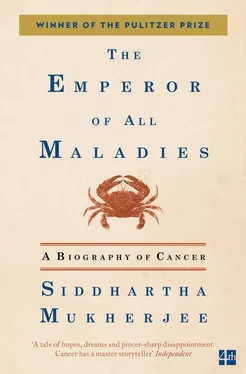But having started this project, Vesalius found that he could not stop. “My drawing of the veins pleased the professors of medicine and all the students so much that they earnestly sought from me a diagram of the arteries and also one of the nerves. . . . I could not disappoint them.” The body was endlessly interconnected: veins ran parallel to nerves, the nerves were connected to the spinal cord, the cord to the brain, and so forth. Anatomy could only be captured in its totality, and soon the project became so gargantuan and complex that it had to be outsourced to yet other illustrators to complete.
But no matter how diligently Vesalius pored through the body, he could not find Galen’s black bile. The word autopsy comes from the Greek “to see for oneself”; as Vesalius learned to see for himself, he could no longer force Galen’s mystical visions to fit his own. The lymphatic system carried a pale, watery fluid; the blood vessels were filled, as expected, with blood. Yellow bile was in the liver. But black bile—Galen’s oozing carrier of cancer and depression—could not be found anywhere.
Vesalius now found himself in a strange position. He had emerged from a tradition steeped in Galenic scholarship; he had studied, edited, and republished Galen’s books. But black bile—that glistening centerpiece of Galen’s physiology—was nowhere to be found. Vesalius hedged about his discovery. Guiltily, he heaped even more praise on the long-dead Galen. But, an empiricist to the core, Vesalius left his drawings just as he saw things, leaving others to draw their own conclusions. There was no black bile. Vesalius had started his anatomical project to save Galen’s theory, but, in the end, he quietly buried it.

In 1793, Matthew Baillie, an anatomist in London, published a textbook called The Morbid Anatomy of Some of the Most Important Parts of the Human Body. Baillie’s book, written for surgeons and anatomists, was the obverse of Vesalius’s project: if Vesalius had mapped out “normal” anatomy, Baillie mapped the body in its diseased, abnormal state. It was Vesalius’s study read through an inverted lens. Galen’s fantastical speculations about illnesses were even more at stake here. Black bile may not have existed discernably in normal tissue, but tumors should have been chock-full of it. But none was to be found. Baillie described cancers of the lung (“as large as an orange” 134), stomach (“a fungous appearance” 135), and the testicles (“a foul deep ulcer” 136) and provided vivid engravings of these tumors. But he could not find the channels of bile anywhere—not even in his orange-size tumors, nor in the deepest cavities of his “foul deep ulcers.” If Galen’s web of invisible fluids existed, then it existed outside tumors, outside the pathological world, outside the boundaries of normal anatomical inquiry—in short, outside medical science. Like Vesalius, Baillie drew anatomy and cancer the way he actually saw it. At long last, the vivid channels of black bile, the humors in the tumors, that had so gripped the minds of doctors and patients for centuries, vanished from the picture.
“Remote Sympathy”
In treating of cancer 137, we shall remark, that little or no confidence should be placed either in internal . . . remedies, and that there is nothing, except the total separation of the part affected.
—A Dictionary of Practical Surgery, 1836
Matthew Baillie’s Morbid Anatomy laid the intellectual foundation for the surgical extractions of tumors. If black bile did not exist, as Baillie had discovered, then removing cancer surgically might indeed rid the body of the disease. But surgery, as a discipline, was not yet ready for such operations. In the 1760s, a Scottish surgeon, John Hunter, Baillie’s maternal uncle, had started to remove tumors from his patients in a clinic in London in quiet defiance of Galen’s teachings. But Hunter’s elaborate studies—initially performed on animals and cadavers in a shadowy menagerie in his own house—were stuck at a critical bottleneck. He could nimbly reach down into the tumors and, if they were “movable” (as he called superficial, noninvasive cancers), pull them out without disturbing the tender architecture of tissues underneath. “If a tumor is not only movable 138but the part naturally so,” Hunter wrote, “they may be safely removed also. But it requires great caution to know if any of these consequent tumors are within proper reach, for we are apt to be deceived.”
That last sentence was crucial. Albeit crudely, Hunter had begun to classify tumors into “stages.” Movable tumors were typically early-stage, local cancers. Immovable tumors were advanced, invasive, and even metastatic. Hunter concluded that only movable cancers were worth removing surgically. For more advanced forms of cancer, he advised an honest, if chilling, remedy reminiscent of Imhotep’s: “remote sympathy.”*
Hunter was an immaculate anatomist, but his surgical mind was far ahead of his hand. A reckless and restless man with nearly maniacal energy who slept only four hours a night, Hunter had practiced his surgical skills endlessly on cadavers from every nook of the animal kingdom—on monkeys, sharks, walruses, pheasants, bears, and ducks. But with live human patients, he found himself at a standstill. Even if he worked at breakneck speed, having drugged his patient with alcohol and opium to near oblivion, the leap from cool, bloodless corpses to live patients was fraught with danger. As if the pain during surgery were not bad enough, the threat of infections after surgery loomed. Those who survived the terrifying crucible of the operating table often died even more miserable deaths in their own beds soon afterward.

In the brief span between 1846 and 1867, two discoveries swept away these two quandaries that had haunted surgery, thus allowing cancer surgeons to revisit the bold procedures that Hunter had tried to perfect in London.
The first of these discoveries, anesthesia, was publicly demonstrated in 1846 in a packed surgical amphitheater at Massachusetts General Hospital, less than ten miles from where Sidney Farber’s basement laboratory would be located a century later. At about ten o’clock on the morning of October 16, a group of doctors gathered in a pitlike room at the center of the hospital. A Boston dentist, William Morton, unveiled a small glass vaporizer, containing about a quart of ether, fitted with an inhaler. He opened the nozzle and asked the patient, Edward Abbott, a printer, to take a few whiffs of the vapor. As Abbott lolled into a deep sleep, a surgeon stepped into the center of the amphitheater and, with a few brisk strokes, deftly made a small incision in Abbott’s neck and closed a swollen, malformed blood vessel (referred to as a “tumor,” conflating malignant and benign swellings) with a quick stitch. When Abbott awoke a few minutes later, he said, “I did not experience pain 139at any time, though I knew that the operation was proceeding.”
Anesthesia—the dissociation of pain from surgery—allowed surgeons to perform prolonged operations, often lasting several hours. But the hurdle of postsurgical infection remained. Until the mid-nineteenth century, such infections were common and universally lethal, but their cause remained a mystery. “It must be some subtle principle 140contained [in the wound],” one surgeon concluded in 1819, “which eludes the sight.”
In 1865, a Scottish surgeon named Joseph Lister made an unusual conjecture on how to neutralize that “subtle principle” lurking elusively in the wound. Lister began with an old clinical observation: wounds left open to the air would quickly turn gangrenous, while closed wounds would often remain clean and uninfected. In the postsurgical wards of the Glasgow infirmary, Lister had again and again seen an angry red margin begin to spread out from the wound and then the skin seemed to rot from inside out, often followed by fever, pus, and a swift death (a bona fide “suppuration”).
Читать дальше













